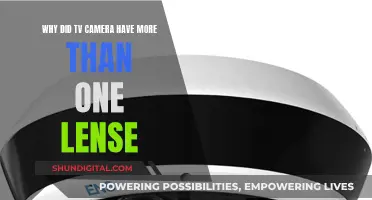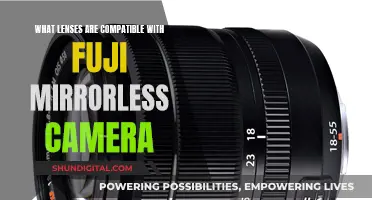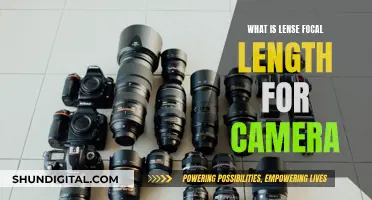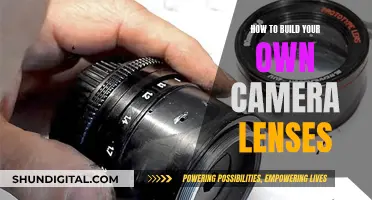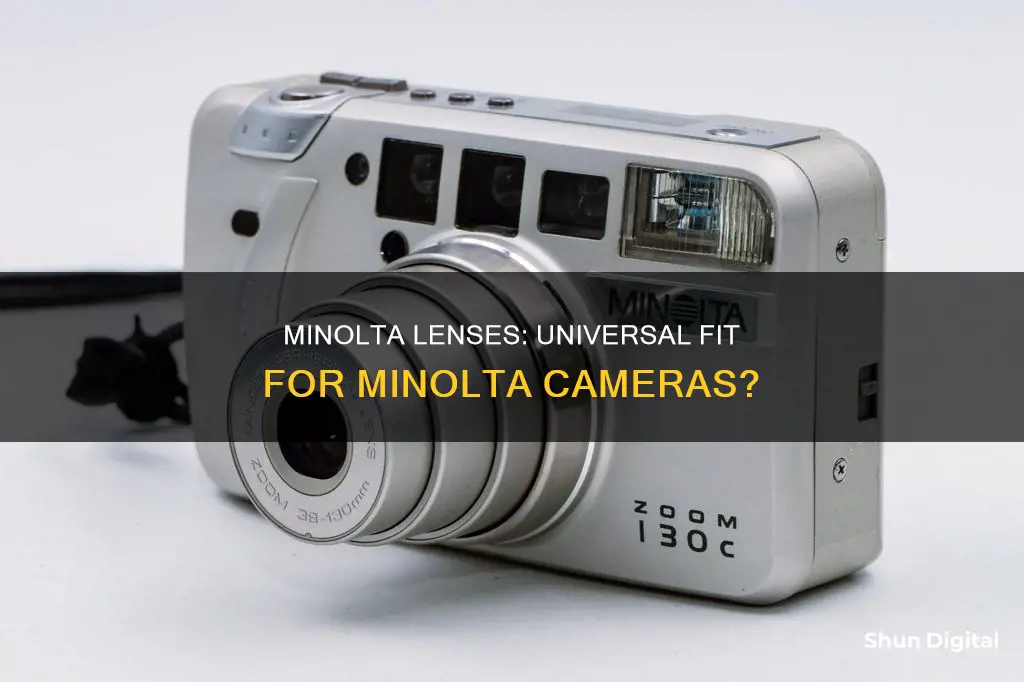
The compatibility of Minolta lenses with Minolta cameras depends on the type of lens and camera in question. Minolta SR-mount lenses, which were introduced in 1958 and succeeded by the incompatible A-mount in 1985, cannot be adapted to DSLRs from brands like Canon, Nikon, Pentax, and Sony due to their shorter flange focal distance. However, these lenses can be easily adapted for use with mirrorless cameras. On the other hand, Minolta A-mount lenses are compatible with Sony A-mount cameras, and Minolta AF lenses work on Sony Alpha DSLRs and SLTs without adapters. Adapters are available for using Minolta lenses with certain Canon, Nikon, and Sony camera models, but they may have limitations and require manual adjustments for aperture and focus.
| Characteristics | Values |
|---|---|
| Minolta lens compatibility with other camera brands | Sony Alpha (A-mount) dSLRs and dSLTs without any adapters |
| Can be adapted to Sony E-mount (NEX) | |
| Canon EOS with an adapter ring, but this is not recommended due to the small difference in registration distance between Minolta AF (44.5mm) and Canon EOS (44mm) | |
| Nikon F with an adapter, but this will require manual focus and aperture control | |
| Minolta A-mount lenses | Compatible with Sony A-mount cameras |
| Minolta SR-mount lenses | Not compatible with DSLRs due to the short flange focal distance of 43.5mm |
| Compatible with mirrorless cameras | |
| Minolta M-mount lenses | Released in cooperation with Leica |
What You'll Learn

Minolta A-mount lenses are compatible with Sony A-mount cameras
The Minolta A-mount lenses are compatible with Sony A-mount cameras. In 2006, Sony took over the Minolta A-mount system and rebranded 12 lenses as Sony A-mount lenses. These lenses are optically, mechanically, and electrically identical to their Minolta predecessors, with only minor changes to their outer appearance.
Minolta A-mount lenses can be used on Sony Alpha (A-mount) DSLRs and SLTs without the need for any adapters. However, when adapting lenses to different camera mounts, the registration distance is crucial. The registration distance is the distance between the lens and the image plane, and it must be maintained for the lens to focus properly through the full range of distances to infinity.
While Minolta AF lenses can be adapted to fit Sony E-mount (NEX) cameras, they cannot be adapted to fit Canon EOS cameras due to the small difference in registration distance between the two systems. Adapting a Minolta AF lens to a Canon EOS camera would require an adapter ring that is too thin to be practical.
Additionally, adapting lenses between different mounts may result in a loss of functionality. For example, adapting a Minolta AF lens to a Canon EOS camera would result in the loss of autofocus, aperture control, and EXIF information. It would also require manual focusing and metering, and the camera would be limited to shooting in M or Av modes.
How Camera Lenses Form Images: Inverted or Upright?
You may want to see also

Minolta SR-mount lenses can be adapted to mirrorless cameras
The Minolta SR-mount was the bayonet mounting system used in all 35 mm SLR cameras made by Minolta with interchangeable manual focusing lenses. The SR-mount was replaced by the Minolta A-mount in 1985.
There are also adapters for Minolta/Sony A-mount cameras, but they either do not maintain infinity focus or contain glass elements that work as teleconverters, changing the optical properties and often deteriorating image quality.
Understanding Camera Lenses: Long Focal Points Explained
You may want to see also

Minolta AF lenses are compatible with Sony Alpha cameras
The Minolta A-mount camera system was introduced in 1985 as the world's first integrated autofocus system in the camera body with interchangeable lenses. The system used a lens mount called A-mount, with a flange focal distance of 44.50 mm.
While Minolta AF lenses work just fine on Sony Alpha (A-mount) DSLRs and SLTs without any adapters, they are not compatible with Canon EOS. This is due to the registration distance, which is the distance at which the lens is held from the image plane. With Minolta AF (44.5mm registration) to Canon EOS (44mm registration), the difference is too small to practically machine an adapter ring to overcome the differences in the bayonet flanges.
To adapt Minolta AF lenses to Canon EOS, an adapter with a glass element is required to act as a short teleconverter so the lens can still focus to infinity. However, this will affect image quality and decrease the max aperture, and increase the focal length of the adapted lens. Additionally, Minolta AF lenses lack an aperture ring, which means that without electronic communication, the lens will be stuck shooting wide open all the time.
Japan's Camera Lens Market: Affordable Photography Superpower?
You may want to see also

Minolta AF lenses can be adapted to Sony E-mount (NEX)
The Minolta AF lens mount was introduced in 1985 with the Minolta 7000, the first autofocus system camera for the mass market. Minolta AF lenses were named Maxxum AF lenses in the USA.
While Minolta AF lenses work just fine on Sony Alpha (A-mount) DSLRs and SLTs without any adapters, they can also be adapted to mount on the Sony E-mount (NEX). However, it is not possible to adapt Minolta AF lenses to Canon EOS due to the small difference in registration distance between the two systems.
When adapting lenses between different mount systems, it is typically only possible to adapt from a system with a larger registration distance to one with a smaller one. This is because adapter rings always add to the distance, and physically modifying the mount itself is usually not an option. In the case of Minolta AF to Canon EOS, the difference in registration distance is only 0.5mm, which is too thin for a metal ring to hold up reliably.
It is possible to adapt from a smaller registration distance to a larger one by using an adapter with a lens, but this will affect image quality and decrease the maximum aperture. Additionally, without electronic communication between the lens and the body, there will be no autofocus, no aperture control from the camera, and no EXIF information from the lens.
All DSLRs and SLTs of the Sony Alpha system have an autofocus lens bayonet that is downward compatible with all lenses of Minolta's 35mm AF System.
CCD Camera Lenses: Color Corrected or Not?
You may want to see also

Minolta AF lenses are not compatible with Canon EOS
While it may be possible to adapt Minolta AF lenses to Canon EOS cameras using an adapter with a lens, this is not recommended as it will affect image quality and decrease the maximum aperture. Additionally, Minolta AF lenses do not have an aperture ring, which means that without electronic communication between the lens and the camera body, you will be stuck shooting with the aperture wide open all the time.
Minolta AF lenses are, however, compatible with Sony Alpha (A-mount) DSLRs and DSLTs without the need for any adapters.
How Camera Lenses Use Refraction to Capture Images
You may want to see also
Frequently asked questions
Yes, you can use Minolta lenses on non-Minolta cameras, but you will need an adapter. The type of adapter you will need depends on the camera and lens mounts.
Yes, you can use some non-Minolta lenses on Minolta cameras, but you will need an adapter. The type of adapter you will need depends on the camera and lens mounts.
No, you do not need an adapter to use Minolta lenses on a Minolta camera, as long as the lens and camera mounts are compatible.
Yes, there are some Minolta lenses that cannot be used with adapters, such as the Minolta A-mount lenses, which have a longer flange focal distance than the MD/MC lenses.


